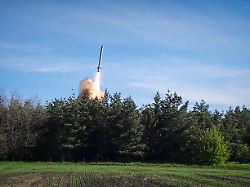“European Sky Shield”
How Europe wants to protect itself from missiles
7/7/2023, 8:18 p.m
When it comes to ballistic missile defense, there are gaps in Europe’s defenses. Germany wants to close this together with 18 other countries. How far the plans for an air defense system have progressed and who is taking part – an overview.
What is the “European Sky Shield” initiative?
With the “European Sky Shield”, Germany and more than a dozen other allies want to build up a European air defense system. The aim of the protective shield is to close gaps in air defense. Different systems are to be integrated into the defensive shield suggested by Germany, which are suitable for defending against medium- and long-range missiles or armed drones – also to protect against possible attacks from Russia.
Federal Defense Minister Boris Pistorius speaks of a European “sky shield”. According to him, the initiative “was not started as a strategic military alliance, but above all as a procurement cooperation”. It ensures that systems can be used in a coordinated manner.
Why does the initiative exist?
According to the German government, Russia’s attacks on Ukraine have made it clear that it is necessary to build up a European air defense system. The Federal Ministry of Defense points out that Russia is “frequently using unmanned systems, ballistic missiles, cruise missiles and hypersonic missiles in Ukraine”. This shows how important an efficient air defense is for Europe in order to be able to counteract future threats.
At the end of August last year, Federal Chancellor Olaf Scholz described joint air defense as a “security gain for the whole of Europe”. In addition, it is “more cost-effective and efficient than if each of us builds our own, expensive and highly complex air defense system”.
What is planned in the initiative?
The countries joined in the alliance want to buy air defense systems together. According to the Federal Ministry of Defense, the modern German air defense system Iris-T SLM, which is already being used in Ukraine, is to be acquired. The States also rely on the US-made Patriot and Israeli Arrow systems.
Where are there gaps in air defense so far?
According to the Federal Ministry of Defense, there is a gap in the defense against long-range ballistic missiles. This must be closed quickly – especially since Russia has these weapons. There are also gaps and a need to expand capabilities at short and medium ranges “with a view to possible close-range air attacks, including threats from drones”.
Who is participating?
In addition to Germany, Scholz’s proposal for a “European Sky Shield” has so far been endorsed by 18 countries – including two of Germany’s neighboring countries, Austria and Switzerland. In addition to states such as Great Britain and the Netherlands, a number of Eastern European countries are also taking part. According to the Federal Ministry of Defense, the initiative is open to other interested states.
What about other European countries?
There is disagreement within Europe with regard to the “European Sky Shield”. France, Italy and Poland have not joined the initiative. Paris objects to the fact that technology from Israel and the USA is also to be purchased for the project – i.e. technology that does not come from Europe.
Instead, France relies on the SAMP/T – Mamba type ground-to-air system developed with Italy. In addition, France wants to buy several hundred Mistral surface-to-air missiles together with four other countries. This in turn arouses the suspicion among critics in Germany that France primarily wants to promote its own armaments industry.
What is the relationship between the “European Sky Shield” and NATO?
According to the German Defense Ministry, the European airspace defense system is intended to strengthen the “European pillar in NATO”. It is intended to integrate the capabilities into the air defense of the NATO area led by the NATO commander for Europe. But there are also non-NATO member states, such as Austria and Switzerland. According to Swiss Defense Minister Viola Amherd, both countries have set out their “reservations under neutrality law” in an additional declaration.
